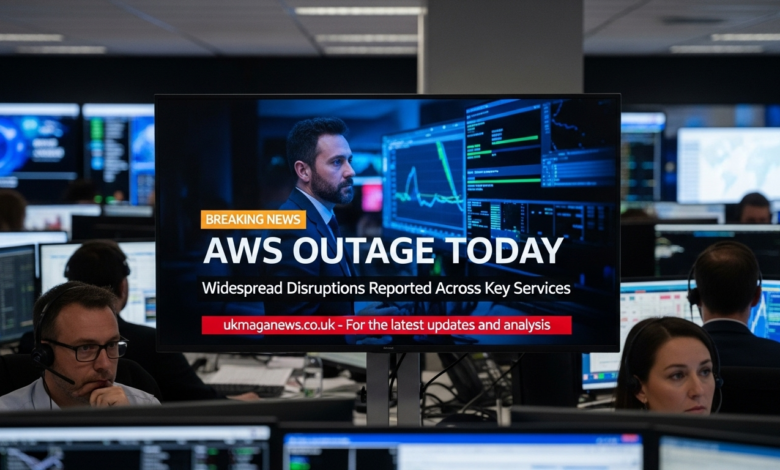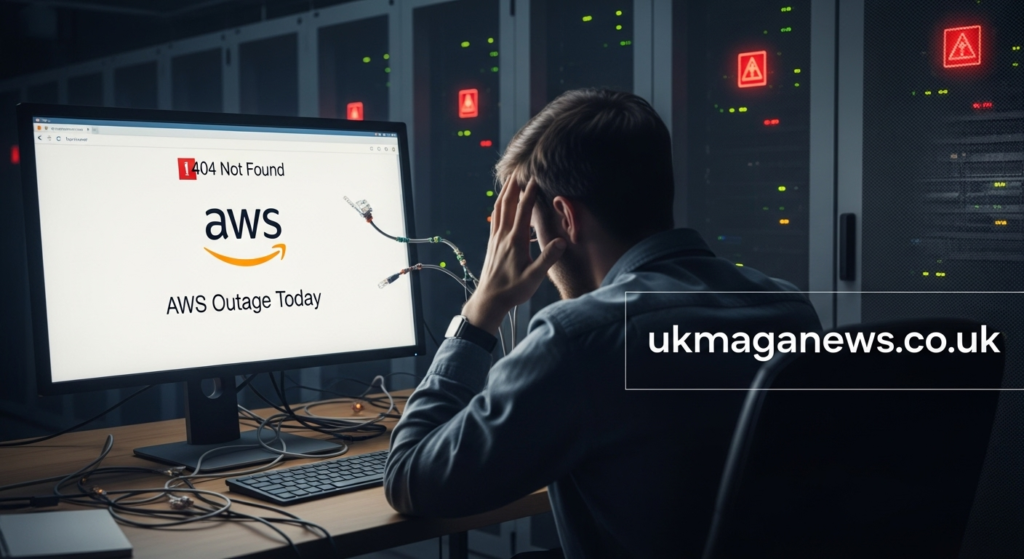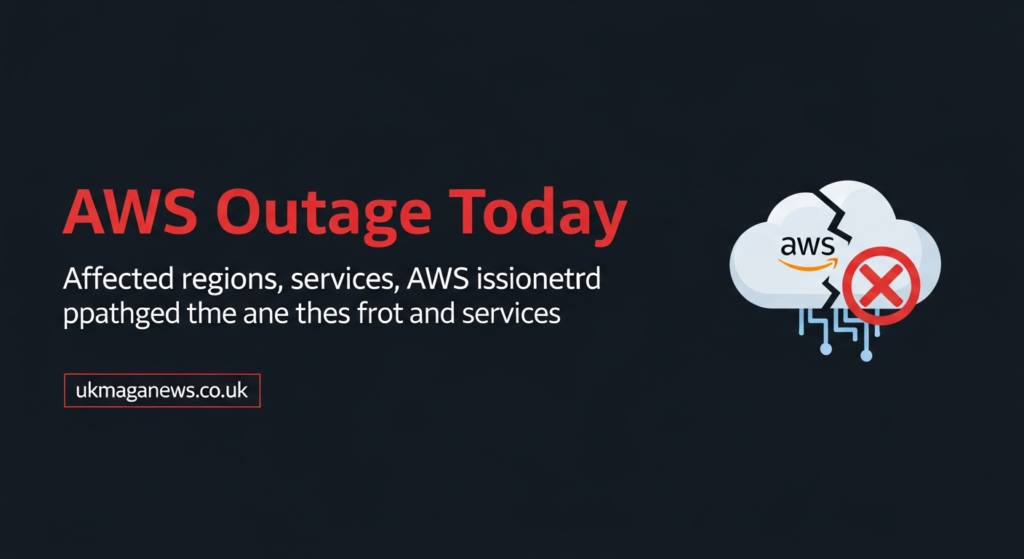AWS Outage Today: Critical Impact and Recovery Solutions

Introduction
Your website just went dark. Your app stopped responding. Customer complaints are flooding in. If this sounds familiar, you’re not alone. The aws outage today has affected countless businesses and services across the globe, leaving developers and companies scrambling for answers.
Amazon Web Services powers a massive portion of the internet. When AWS experiences problems, the ripple effects touch everything from streaming platforms to banking apps. Understanding what caused the aws outage today and how to respond can mean the difference between minimal disruption and major losses.
In this article, we’ll break down exactly what happened during the aws outage today. You’ll learn which regions and services were affected, how long the disruption lasted, and most importantly, what you can do to protect your business from similar incidents in the future. Whether you’re a developer, IT professional, or business owner, this information could save you significant headaches down the road.
What Is AWS and Why Does It Matter?
Amazon Web Services represents the backbone of modern internet infrastructure. The platform provides cloud computing services to millions of customers worldwide. From startups to Fortune 500 companies, organizations rely on AWS to host their applications, store data, and deliver content.
AWS operates through data centers spread across multiple geographic regions. Each region contains multiple availability zones designed to provide redundancy. This architecture theoretically protects against localized failures. However, when problems occur at a regional or service level, the impact can be widespread.
The scope of AWS’s reach is staggering. Netflix streams through AWS. Spotify delivers music via AWS infrastructure. Even government agencies and healthcare systems depend on these services. When AWS goes down, a significant portion of the digital world feels the impact.
Understanding this context helps explain why the aws outage today created such widespread concern. It’s not just one company having server problems. It’s a fundamental piece of internet infrastructure experiencing issues that cascade across industries and continents.
Timeline of the AWS Outage Today
The aws outage today began affecting users at different times depending on their location and services. Initial reports started appearing on social media and status monitoring sites as users noticed connectivity problems. Services that had been running smoothly suddenly became unavailable or severely degraded.
AWS acknowledged the issue through their official status dashboard. The company provides real time updates during outages, though information sometimes lags behind what users are experiencing. This communication gap can frustrate customers trying to understand the severity and expected duration.
The peak of the disruption saw multiple services experiencing problems simultaneously. EC2 instances became unreachable in affected regions. S3 buckets returned errors. Lambda functions failed to execute. The cascading nature of these failures compounded the problem as dependent services also went down.
Recovery efforts began as AWS engineering teams identified the root cause. Gradual restoration of services occurred over several hours. Some customers regained access quickly while others experienced extended downtime. Full resolution took longer than many hoped, highlighting the complexity of modern cloud infrastructure.

Which AWS Services Were Affected?
The aws outage today impacted several core AWS services. EC2, the compute service that powers countless applications, experienced significant disruptions. Virtual machines became inaccessible, preventing users from managing their instances or deploying updates.
S3 storage buckets also faced problems during the outage. This affected websites using S3 for static content hosting. Applications relying on S3 for data storage encountered errors. Even AWS’s own console uses S3, creating a circular dependency that complicated troubleshooting.
Here are the primary services that experienced issues:
- EC2 (Elastic Compute Cloud): Virtual server instances became unreachable or unresponsive
- S3 (Simple Storage Service): Object storage experienced elevated error rates and slow performance
- RDS (Relational Database Service): Database connectivity issues affected data driven applications
- Lambda: Serverless functions failed to trigger or execute properly
- CloudFront: Content delivery network experienced degraded performance
- Route 53: DNS service disruptions affected domain resolution
Secondary effects rippled through dependent services. Elastic Beanstalk deployments failed. CloudFormation stacks couldn’t update. Even monitoring tools like CloudWatch struggled to report accurate data. This interconnected nature of cloud services means a single point of failure can cascade unexpectedly.
Geographic Regions Most Impacted
The aws outage today primarily affected specific AWS regions. US East 1, located in Northern Virginia, bore the brunt of the disruption. This region is AWS’s oldest and largest, hosting a disproportionate amount of customer workloads.
Other regions experienced varying degrees of impact. US West 2 reported some connectivity issues. European regions showed minor disruptions. The global nature of modern applications meant even customers not directly in affected regions noticed problems.
Why does US East 1 matter so much? Many organizations default to this region for historical reasons. It offers the most services and features first. Pricing can be slightly better. However, this concentration creates risk. When US East 1 struggles, a huge portion of AWS customers feel the pain.
Geographic redundancy should protect against regional outages. However, many companies don’t implement true multi region architectures. Cost concerns, complexity, and data sovereignty issues keep workloads concentrated. The aws outage today reminded everyone why geographic distribution matters.
Root Cause Analysis of Today’s Outage
Understanding what caused the aws outage today helps prevent future incidents. While AWS hasn’t always released detailed post mortems immediately, patterns emerge from previous outages. Network issues frequently trigger these events. Configuration changes gone wrong can cascade through systems.
One common culprit involves internal DNS or routing problems. AWS’s own infrastructure depends on complex networking. When these foundational services fail, everything built on top suffers. Automated systems designed to detect and route around failures sometimes exacerbate problems instead.
Human error also plays a role in some outages. A misconfigured update or incorrectly executed maintenance procedure can trigger widespread failures. AWS employs extensive testing and rollout procedures, but with infrastructure this complex, mistakes happen.
Capacity constraints occasionally contribute to outages. Sudden traffic spikes or resource exhaustion can overwhelm systems. While AWS designs for massive scale, unprecedented demand or unexpected usage patterns can exceed planned capacity. The interconnected nature of services means problems in one area quickly affect others.
Real World Impact on Businesses
The aws outage today created immediate financial consequences for affected businesses. E commerce sites lost sales during the downtime. Streaming services couldn’t deliver content to subscribers. SaaS platforms failed to serve their customers, damaging reputation and trust.
Customer facing impacts extended beyond revenue. Users couldn’t access their accounts. Mobile apps displayed error messages. Essential services like healthcare portals or financial platforms became unavailable. The modern expectation of 24/7 availability makes any disruption feel unacceptable.
Internal business operations also ground to halt. Companies using AWS for internal tools couldn’t access critical systems. Development teams couldn’t deploy code. Data analysts lost access to dashboards and reports. The productivity loss compounds over time.
Smaller businesses and startups often feel outage impacts more acutely. They typically lack the resources for elaborate redundancy. A few hours of downtime can mean missing crucial deadlines or losing competitive advantages. The aws outage today highlighted the vulnerability many organizations face.
How Companies Responded to the Outage
When the aws outage today struck, companies activated their incident response procedures. IT teams jumped on conference calls to assess the situation. Status pages were updated to inform customers. Customer support prepared for the inevitable flood of inquiries.
Some organizations could failover to backup systems in other regions. Those with proper disaster recovery plans executed predetermined procedures. However, many discovered their backup strategies had gaps. Testing disaster recovery in theory differs from executing it during an actual crisis.
Communication became crucial during the outage. Companies sent emails to customers explaining the situation. Social media updates kept stakeholders informed. Transparency about the AWS dependency and expected resolution timeline helped manage expectations.
Post outage, businesses began reviewing their architecture. Conversations about multi cloud strategies intensified. Teams evaluated whether mission critical systems needed additional redundancy. The aws outage today served as an expensive reminder about single points of failure.
Comparing This Outage to Previous AWS Incidents
The aws outage today joins a history of notable AWS disruptions. In 2017, an S3 outage in US East 1 took down large portions of the internet. A typo in a command during routine maintenance triggered that incident, demonstrating how small mistakes create big problems.
More recently, AWS experienced outages affecting specific services or regions. Each incident taught lessons about infrastructure resilience. AWS improved monitoring, changed procedures, and added safeguards. Yet outages continue occurring, reminding us that perfect uptime remains elusive.
This outage shares similarities with past events. The same geographic concentration in US East 1 creates recurring vulnerabilities. The cascading failure pattern repeats across incidents. However, AWS’s response times have generally improved. Communication has become more transparent.
Frequency matters when evaluating cloud reliability. AWS maintains impressive overall uptime statistics. Even 99.99% uptime allows for some downtime annually. The question becomes whether that level meets your business requirements. The aws outage today prompts each organization to honestly assess their risk tolerance.
Understanding AWS Service Level Agreements
AWS provides Service Level Agreements that define expected uptime and remedies for failures. These SLAs vary by service. EC2 typically promises 99.99% uptime within a region. S3 offers different guarantees depending on storage class.
However, SLAs don’t prevent outages. They only provide compensation after the fact. For most services, credits represent a small percentage of monthly charges. These credits don’t cover the actual business impact you suffered during downtime.
Reading SLA fine print reveals important limitations. Multi availability zone deployments may be required for full SLA coverage. Certain failure scenarios fall outside SLA terms. You need to architect for reliability rather than relying solely on AWS guarantees.
The aws outage today likely triggered SLA credit eligibility for affected customers. Filing claims requires documentation and following specific procedures. While financial compensation helps, it doesn’t undo the operational impact and customer dissatisfaction you experienced.
Best Practices for AWS Outage Preparedness
Protecting against future outages like the aws outage today requires proactive planning. Multi availability zone deployment should be your baseline. Spreading resources across availability zones within a region provides protection against localized failures.
Multi region architecture offers even greater resilience. Replicating critical systems across geographic regions allows failover when an entire region experiences problems. The complexity and cost increase significantly, but so does your reliability.
Consider these essential preparation steps:
- Implement health checks and monitoring: Know immediately when services become unavailable
- Create runbooks for common scenarios: Document exact steps for various failure modes
- Test disaster recovery procedures regularly: Quarterly failover tests reveal gaps before real emergencies
- Design for graceful degradation: Applications should handle AWS service failures without completely breaking
- Maintain updated status communication channels: Keep customers informed during incidents
Backup strategies extend beyond AWS. Some companies maintain presence on multiple cloud providers. Others keep critical components on premises. True redundancy means AWS failure doesn’t equal complete system failure.
Multi Cloud Strategy Considerations
The aws outage today renewed interest in multi cloud approaches. Distributing workloads across AWS, Google Cloud, and Azure reduces dependency on any single provider. When one cloud experiences problems, others hopefully remain operational.
However, multi cloud introduces its own complexities. Managing multiple platforms requires broader expertise. Costs often increase due to reduced volume discounts and management overhead. Data transfer between clouds can be expensive and slow.
Abstraction layers help manage multi cloud complexity. Kubernetes provides portable container orchestration across clouds. Terraform offers infrastructure as code that works with multiple providers. These tools reduce vendor lock in but require additional learning and maintenance.
For many organizations, multi cloud represents overkill. The added complexity outweighs benefits unless you’re at significant scale. Proper multi region deployment within a single cloud often provides sufficient protection. The aws outage today highlights the need for redundancy, but that doesn’t automatically mean multi cloud is the answer.
Cost Implications of Downtime
Calculating the financial impact of the aws outage today involves multiple factors. Direct revenue loss from unavailable e commerce or subscription services is easiest to quantify. Multiply average revenue per hour by downtime duration for a baseline figure.
Indirect costs prove harder to measure but equally significant. Customer trust erosion affects future revenue. Brand reputation damage can take months to repair. Lost productivity for employees unable to work compounds over time.
Industry research suggests downtime costs vary dramatically by sector:
- E commerce loses an average of $5,600 per minute during outages
- Financial services can lose over $9,000 per minute
- Social media platforms estimate $90,000 or more per minute
- Smaller businesses might lose hundreds to thousands per hour
These figures don’t include long term customer churn. A frustrated user might switch to competitors. Negative social media posts damage your brand beyond the outage duration. The true cost of the aws outage today extends far beyond immediate losses.
Monitoring and Alert Systems During Outages
Effective monitoring becomes crucial during incidents like the aws outage today. Your monitoring systems should detect problems before customers report them. However, when AWS itself experiences issues, cloud based monitoring can fail too.
Diverse monitoring approaches provide better coverage. Use third party monitoring services hosted outside AWS. Implement synthetic monitoring that actively tests functionality. Create alerts that notify through multiple channels so you receive warnings even if one system fails.
AWS CloudWatch provides native monitoring but suffers during AWS outages. External services like Datadog, New Relic, or Pingdom offer independent perspectives. They can alert you to AWS problems even when AWS’s own monitoring struggles.
Status page services let you communicate with customers proactively. Tools like StatusPage or Sorry help you update stakeholders during incidents. Transparency about ongoing issues and expected resolution builds trust even when things aren’t working perfectly.
Communication Strategies During Service Disruptions
How you communicate during outages like the aws outage today shapes customer perception. Prompt acknowledgment of problems demonstrates you’re aware and working on solutions. Silence breeds frustration and speculation.
Your status page should be your first update channel. Post initial notification as soon as you confirm an issue. Provide regular updates even if just to say you’re still investigating. Customers appreciate knowing you’re actively engaged.
Social media requires careful management during outages. Frustrated customers vent publicly. Respond professionally and direct them to official status updates. Avoid making promises about resolution times unless you’re confident you can meet them.
Internal communication matters equally. Keep your team informed about the situation. Coordinate response efforts through designated incident commanders. Clear internal communication prevents confusion and ensures everyone pushes toward resolution together.
Recovery and Post Outage Analysis
After service restoration following the aws outage today, the real work begins. Conducting thorough post mortems helps prevent recurrence. Gather your team while details remain fresh. Document exactly what happened, how you responded, and what you learned.
Post mortem meetings should focus on systems and processes, not blame. A blameless culture encourages honest discussion about failures. People won’t share valuable lessons if they fear punishment for mistakes.
Action items from post mortems require follow through. Assign owners and deadlines for improvements. Schedule reviews to verify completion. Many organizations conduct excellent post mortems but fail to implement recommendations.
Testing changes before the next incident validates your improvements. Run tabletop exercises walking through similar scenarios. Execute actual failover tests verifying your redundancy works. The aws outage today provides a real world scenario to test against.

Alternative Cloud Providers and Options
The aws outage today prompts evaluation of alternatives. Google Cloud Platform offers comparable services with different infrastructure. Microsoft Azure brings enterprise focused solutions and hybrid cloud capabilities. Each has strengths and weaknesses compared to AWS.
Smaller providers like DigitalOcean or Linode serve certain niches well. They offer simpler interfaces and sometimes better pricing for basic workloads. However, they lack the breadth of services and global reach that AWS provides.
On premises infrastructure remains viable for some organizations. Complete control over your stack eliminates cloud provider dependencies. However, capital costs, maintenance burden, and scaling challenges make this option less attractive for most.
Hybrid approaches combine cloud and on premises resources. Keep critical systems on premises while using cloud for burst capacity or non critical workloads. This balances control with flexibility but introduces complexity at the integration points.
Future of Cloud Reliability and Resilience
The aws outage today represents part of cloud computing’s evolution. As infrastructure grows more complex, new failure modes emerge. However, providers continuously improve reliability through better engineering and operational practices.
Automation helps prevent human errors that trigger some outages. Machine learning can predict potential failures before they occur. Chaos engineering practices deliberately introduce failures to validate resilience.
Industry standards around cloud reliability continue maturing. Shared responsibility models clarify which aspects providers manage versus customers. Certification programs verify security and compliance practices.
Expect transparency to increase around outages and performance. Customers demand detailed post mortems and clearer communication. Competitive pressure pushes providers toward better reliability as a key differentiator.
Building Truly Resilient Applications
Creating applications that survive outages like the aws outage today requires deliberate architectural choices. Design for failure from the beginning. Assume any component can fail and plan accordingly.
Microservices architecture isolates failures. When one service goes down, others continue functioning. Circuit breakers prevent cascading failures by stopping requests to unavailable dependencies. Graceful degradation maintains core functionality even when supporting services fail.
Database strategies significantly impact resilience. Read replicas provide redundancy for database queries. Regular backups enable recovery from data loss. Multi region replication protects against regional failures though it introduces complexity.
Caching reduces dependency on backend services. Content delivery networks serve static assets even when origin servers struggle. Client side caching and offline capabilities help applications function during connectivity problems.
Lessons Learned from Today’s Outage
The aws outage today reinforces several critical lessons. First, no cloud provider offers perfect reliability. AWS maintains impressive uptime but outages happen. Your architecture must account for this reality.
Second, geographic concentration creates risk. Spreading resources across regions provides meaningful protection. The cost and complexity are worthwhile for mission critical systems.
Third, testing disaster recovery procedures matters. Many organizations discovered their failover plans had gaps during today’s outage. Regular testing reveals problems before real emergencies.
Finally, communication builds trust during incidents. Keeping stakeholders informed demonstrates professionalism and care. Silence during outages damages relationships more than the technical problems themselves.
Conclusion
The aws outage today served as a stark reminder that even the most reliable infrastructure can fail. Understanding what happened, how it affected services, and what you can do differently prepares you for future incidents. No single solution prevents all downtime, but thoughtful architecture and planning dramatically reduce your risk.
As cloud computing continues evolving, outages will occasionally occur. The question isn’t whether you’ll face disruption but how well you’ll handle it. Implementing the strategies discussed here will help protect your business when the next aws outage today inevitably happens.
Have you experienced impacts from today’s outage? What steps are you taking to improve your resilience? Share your experiences and learn from others facing similar challenges. The cloud community grows stronger by openly discussing both successes and failures.
Frequently Asked Questions
Is AWS currently experiencing an outage?
You can check AWS’s current status by visiting their official Service Health Dashboard at status.aws.amazon.com. This page provides real time information about service availability across all regions. Third party sites like DownDetector also aggregate user reports about AWS problems.
How long do AWS outages typically last?
AWS outage duration varies significantly depending on the cause and affected services. Minor incidents may resolve within 30 minutes to an hour. Major outages affecting core services can last several hours. AWS’s track record shows most issues resolve within two to four hours, though some have extended longer.
Will I get compensation for the AWS outage today?
If the outage violated AWS Service Level Agreements for services you use, you may be eligible for service credits. You must file a claim through your AWS account within a specified timeframe, typically 30 days. Credits usually represent 10 to 25 percent of your monthly charges for affected services.
How can I check if my AWS services are affected?
Monitor the AWS Service Health Dashboard for region specific status updates. Check CloudWatch metrics for your resources if accessible. Implement external monitoring tools that can alert you independently of AWS. Your application’s own health checks and error logs also provide visibility into issues.
What should I do during an AWS outage?
First, confirm the problem is AWS related rather than your own code or configuration. Check AWS status and social media for confirmation. Communicate with your customers about the situation. Activate your incident response plan if you have one. Document the impact for post outage analysis and potential SLA claims.
Can I prevent my application from being affected by AWS outages?
Complete prevention is impossible, but you can minimize impact. Deploy across multiple availability zones within a region for basic redundancy. Implement multi region architecture for critical systems. Design applications to degrade gracefully when dependencies fail. Regular disaster recovery testing ensures your backup plans actually work.
Which AWS region is most reliable?
No single region guarantees perfect reliability. US East 1 experiences more reported incidents partly because it hosts more customers and services. Newer regions may have fewer features but sometimes show better stability. Choose regions based on latency to users, compliance requirements, and service availability rather than solely on historical uptime.
Should I switch from AWS to another cloud provider?
Switching providers because of a single outage is typically not advisable. All cloud providers experience occasional disruptions. Evaluate your overall experience, not just one incident. If AWS repeatedly fails to meet your needs, explore alternatives. However, migration is expensive and time consuming. Consider multi region AWS deployment before switching providers entirely.
How often does AWS have major outages?
AWS maintains over 99.9% uptime across its services. Major outages affecting multiple services or regions occur a few times per year. Minor service specific issues happen more frequently. AWS publishes historical availability data, though interpreting what constitutes a “major” outage varies by perspective and impact.
What is AWS’s track record for reliability?
AWS has generally maintained strong reliability over its history. Most services achieve their published SLA targets of 99.9% to 99.99% uptime. However, several high profile outages have occurred, particularly affecting US East 1. Overall, AWS’s scale and maturity make it one of the more reliable cloud options available today.
Also Read Ukmaganews.co.uk



